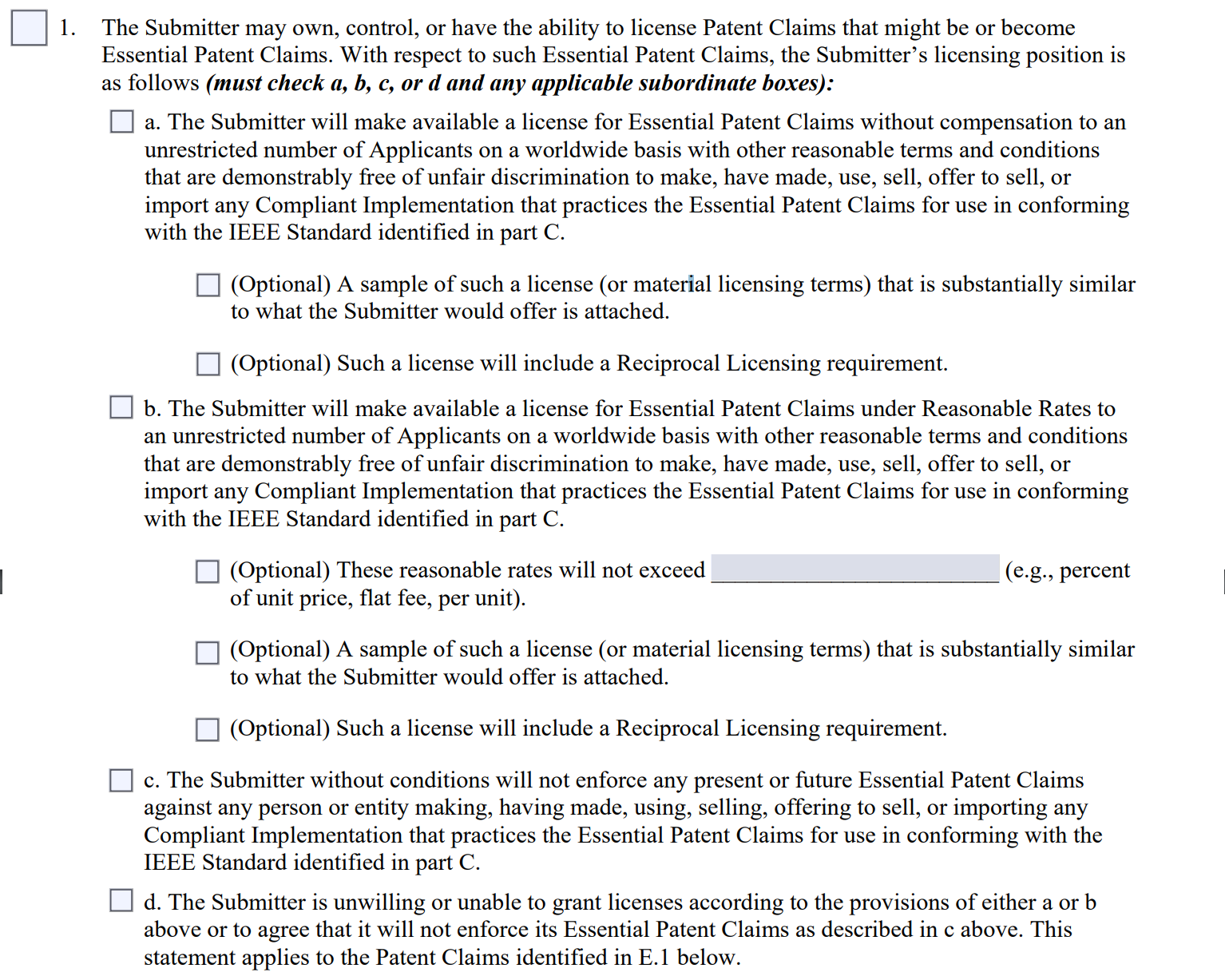IEEE 2015 IPR Policy: Description and Operation
On February 8, 2015, the Institute of Electrical and Electronics Engineers (“IEEE”) approved changes to the IEEE Intellectual Property Rights (IPR) policies that defined Reasonable Rates for royalties relating to/in respect of future IEEE standards and restricted the availability of injunctive relief. This is the first in a series of articles that will explore the 2015 policy and its impact on standards-essential patents licensing.
This article will provide some background and detail what the new policies say and do. The next articles will discuss other relevant aspects of these new policies.
About The IEEE and SEPs
By way of background, the IEEE is a standard-setting organization that has set multiple standards for technologies like Wi-Fi, Ethernet, and many others. During the formation of such standards, IEEE participants submit technical contributions that accomplish the particular technical goals of the standard. If these contributions are included in the standard, any patents that cover them are designated Standard Essential Patents or SEPs. We give an overview of how the standardization process works in this article.
Recognizing that patents provide a right to exclude, organizations like the IEEE request SEP Owners to commit to making available licenses on Reasonable and Non-Discriminatory, or RAND, terms—“FRAND” (Fair, Reasonable and Non-Discriminatory) is a more European version of the term (while RAND is mainly used in the US), but the two are essentially synonyms and often used interchangeably. Worldwide case law also provides guidance on what RAND entails. What’s unique about the 2015 IEEE IPR changes, which are available here, is that for the first time for any standards-setting organization, the IEEE defined what a “Reasonable Rate” computation should consider (see page 2 of this redlined version). The IEEE also limited the availability of injunctions (see page 4, line 146).
IEEE requests Licensing Assurances from patent holders
In terms of operation, the new policy kicks in when “the IEEE receives notice that a [Proposed] IEEE Standard may require the use of a potential Essential Patent Claim.” Once received, “the IEEE shall request licensing assurance, on the IEEE-SA Standards Board approved Letter of Assurance (LOA) form, from the patent holder or patent applicant.”
So, if a standard includes a potential essential patent claim, the IEEE can request licensing assurance. Once this request is received, the patent holder has four options:
Deny awareness of Essential Patent Claim
Submit LOA committing to
License Essential Patent Claim on royalty-free terms, or
License Essential Patent Claim with reasonable royalty, or
Refrain from enforcing Essential Patent Claim
Submit “negative LOA,” declining to give any assurance as to licensing intentions
Not respond
Now let’s explore the definitions of “reasonable rates” and restrictions against injunctive relief.
How the 2015 IPR Policy defines Reasonable Rates
According to the updated IPR policy,
“[D]etermination of such Reasonable Rates should include, but need not be limited to, the consideration of:
• The value that the functionality of the claimed invention or inventive feature within the Essential Patent Claim contributes to the value of the relevant functionality of the smallest saleable Compliant Implementation that practices the Essential Patent Claim.
• The value that the Essential Patent Claim contributes to the smallest saleable Compliant Implementation that practices that claim, in light of the value contributed by all Essential Patent Claims for the same IEEE Standard practiced in that Compliant Implementation.
• Existing licenses covering use of the Essential Patent Claim, where such licenses were not obtained under the explicit or implicit threat of a Prohibitive Order, and where the circumstances and resulting licenses are otherwise sufficiently comparable to the circumstances of the contemplated license.
Restrictions against Injunctions in the 2105 IPR Policy
This provision reads as follows;
“The Submitter of an Accepted LOA who has committed to make available a license for one or more Essential Patent Claims agrees that it shall neither seek nor seek to enforce a Prohibitive Order based on such Essential Patent Claim(s) in a jurisdiction unless: the implementer fails to participate in, or to comply with the outcome of, an adjudication, including an affirming first-level appellate review, if sought by any party within applicable deadlines, in that jurisdiction...”
Future articles will analyze this provision in more detail. For now, one prevalent view is that “Because the revisions place strict limitations on an SEP holder’s ability to enforce its patent rights against infringers, they truncate the upper range of the distribution of bilaterally negotiated RAND royalties and thus unambiguously reduce the compensation that the SEP holder may obtain for its technological contributions to the IEEE standards”. Also, most authorities agree that “This proposed IEEE IPR policy appears contrary to case law and administrative actions that have considered the availability of injunctive relief for standard essential patents and universally agree that injunctive relief should be available against unwilling licensees.”
Letters of Assurance
Once the patent owner receives the request for licensing assurance, it has the four options detailed above, which include not responding. If they choose to respond, the Letter of Assurance Template is available here. Here are the key options in the document.
Section 1 of the IEEE Letter of Assurance Template.
Here’s a quick summary of the four options, a - d.
a. The patent owner agrees to license without compensation, with the option to require a reciprocal agreement from the licensee.
b. The patent owner agrees to license according to the new definition of Reasonable Rates as discussed above, with the other options shown.
c. The patent owner agrees not to enforce the patent claim for Compliant Implementations of the technology.
d. The patent owner is unwilling to grant licenses under a or b, or to agree to c. This is called a Negative Letter of Assurance.
In its September 10, 2020 letter to the IEEE, the US Department of Justice noted that "Since the Policy went into effect, reports show that negative assurances—those in which a technology contributor declines to give a RAND assurance—have increased significantly, comprising 77% of the total Wi-Fi Letters of Assurance at IEEE between January 2016 and June 2019. As a result, in 2019, the American National Standards Institute—a leading nongovernmental body that accredits US standards—declined to approve two proposed IEEE standards amending the 802.11 Wi-Fi standard." This development indicates that the changes to the IPR policy in 2015 did not find consensus among members of IEEE. Rather, probably as a consequence of the composition of the IEEE SA Board (the IEEE’s governing body responsible for modifications to the IEEE-SA Standards Board Bylaws which contain the IPR policy) back at the time, the changes were approved despite internal criticism.
Foto di aymane jdidi da Pixabay

